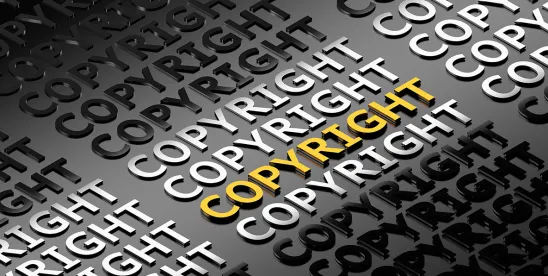In mid-March, a federal appeals court affirmed a ruling finding that artwork created solely by an artificial intelligence (AI) system is not entitled to copyright protection. Thaler v. Perlmutter, No. 23-5233 (D.C. Cir. Mar. 18, 2025). This decision aligns with the position taken by the US Copyright Office in its recent report in light of the ongoing evolution, application, and litigation surrounding AI systems. U.S. Copyright Office, Copyright and Artificial Intelligence, Part 2: Copyrightability (2025).
While this decision may appear straightforward, future developments could arise through an application to the US Supreme Court or through cases addressing the extent of human involvement necessary in AI-generated works that seek copyright protection.
Key Takeaways
- The Copyright Act of 1976 (Act) requires all eligible works to be authored by a human being.
- The Act’s definition of “author” does not apply to machines.
- The work-made-for-hire doctrine requires an existing copyright interest.
- Thaler’s representation that the work was generated autonomously by a computer system weighed heavily against his challenges to the human-authorship requirement and the work-made-for-hire doctrine.
- The Court rejected Dr. Thaler’s arguments that (1) the term “author” is not confined to human beings; (2) the work was made for hire; and (3) the human-authorship requirement prevents protection of works made with AI.
- The Court affirmed the denial of copyright registration where the author of the work was listed as a machine.
Background
Dr. Stephen Thaler, a computer scientist, developed a generative AI system known as the “Creativity Machine,” which generated an artwork titled “A Recent Entrance to Paradise.” In his copyright registration, Dr. Thaler listed the Creativity Machine as the work’s sole author, while he claimed ownership of the work. The Copyright Office denied his application, citing its longstanding requirement that a work must be authored by a human to qualify for copyright protection. Dr. Thaler contested this decision by filing a lawsuit against the Copyright Office and its director, Shira Perlmutter, arguing that the human-authorship requirement was unconstitutional and unsupported by either statute or case law. The district court affirmed the Copyright Office’s decision, and Dr. Thaler appealed to the US Court of Appeals for the District of Columbia Circuit.
Overview of the Case
The appeals court unequivocally sided with the district court’s decision and the Copyright Office’s longstanding requirement that authors must be human.
Dr. Thaler first argued that there is no requirement for an “author” to be a human. Although the Court acknowledged that the Act does not explicitly define “author,” it examined several statutory provisions to conclude that the reading of the Act suggests that an author must be a human, not a machine. See generally, 17 U.S.C. §§ 101, 102(a), 104(a), 108(c)(2), 109(b)(1)(B)(i), 117(d)(1), 201(a), 203(a)(2), 204(a), 302, and 401(a). The provisions considered included:
- An author’s legal capacity to hold property;
- The copyright duration, which extends to the author’s life plus seventy years;
- Inheritance rights for a widow, widower, surviving children, or grandchildren;
- The requirement for a signature to transfer copyright ownership;
- Nationality or domicile;
- The necessity of intention; and
- Definitions of “computer program,” “machine,” “device,” and “process” in the Copyright Act.
The Court concluded that these provisions only make sense if the author is a human. Machines cannot own property, do not have a lifespan that is measured in the same time as that of a human, lack surviving spouses or heirs, cannot provide authenticating signatures, and do not possess a domicile or national identity. Machines also lack the capacity for intention, and the definitions within the Act suggest that machines have an owner who can maintain and repair them. 17 U.S.C. §§ 117(d)(1) and (2). Collectively, these provisions identify an “author” as a human being, and therefore the Court rejected Dr. Thaler’s argument.
Next, Dr. Thaler argued that the work-made-for-hire doctrine allows non-human entities to be considered “authors.” However, the Court noted that AI cannot be an employee under this doctrine, nor can it transfer a copyright it did not author. The Court further explained that if Congress intended an “author” to include non-human entities, it would have explicitly stated that those who hire creators are the “authors,” rather than saying they are “considered the author for purposes of this title.”
Last, Dr. Thaler claimed that the human-authorship requirement prevents the protection of works made with AI. The Court dismissed this concern, clarifying that the requirement does not prohibit copyrighting works that are made with AI assistance; it simply requires the author to be human. The Court also noted that Dr. Thaler did not explain how prohibiting machines from being authors would reduce incentives to create original work, as machines do not respond to economic incentives. Ultimately, the Court emphasized that the human-authorship requirement is not new, and re-addressing it in light of new technology is a policy matter for Congress.
Looking Ahead
Dr. Thaler’s waived argument that he is the work’s author (by creating and using the Creativity Machine) leaves open the significant question of how much human involvement is needed in the conception and creation of a work for creators to claim a copyright. As AI technology rapidly advances and becomes more integrated into various industries, the Court’s reinforcement of the human-authorship requirement serves as a crucial reminder that AI-generated content may not qualify for copyright protection.
For companies investing in AI-driven innovation, it is essential to be mindful of these limitations. Ensuring human involvement in the creative process is not only a legal necessity, but can also be a strategic consideration for securing copyright protection. As businesses seek to protect AI-generated content, including software and creative works, they must carefully evaluate the extent of the human contribution to their works in order to meet the current legal standards. This awareness will be vital in navigating the complex intersection of AI and copyright law, as well as in fostering innovation that aligns with existing legal frameworks.




 />i
/>i

